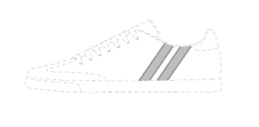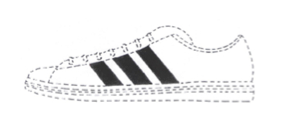Judgment of the General Court of 1 March 2018 ECLI:EU:T:2018:108
“EU trade mark. Application for EU figurative mark consisting of two parallel stripes on a shoe. Earlier EU figurative mark representing three parallel stripes on a shoe. Damage to reputation.
On 1 July 2009, the enterprise Shoe Branding Europe BVBA filed an application for registration of a position mark consisting of two parallel lines positioned on the outside surface of the upper part of a shoe. The goods in respect of which registration is sought fall within Class 25 of the Nice Agreement and correspond to the following description: “footwear.”

The enterprise Adidas AG filed a notice of opposition under Article 46 of Regulation 2017/1001, based on earlier German and EU figurative marks, registered in Class 25 for “footwear,” consisting of three parallel stripes of the same length and width incorporated in the upper part of the footwear.
 The opposition filed by Adidas was initially dismissed by EUIPO by means of decision of the Board of Appeal of 28 November 2013 considering that there was no likelihood of confusion between both trade marks. However, the General Court annulled this decision by means of Judgment of 21 May 2015 on the ground that the decision of EUIPO had wrongly concluded that there was no similarity between the trade marks and based on that erroneous conclusion considered that there was no likelihood of confusion. An appeal was brought against the Judgment and said appeal was dismissed.
The opposition filed by Adidas was initially dismissed by EUIPO by means of decision of the Board of Appeal of 28 November 2013 considering that there was no likelihood of confusion between both trade marks. However, the General Court annulled this decision by means of Judgment of 21 May 2015 on the ground that the decision of EUIPO had wrongly concluded that there was no similarity between the trade marks and based on that erroneous conclusion considered that there was no likelihood of confusion. An appeal was brought against the Judgment and said appeal was dismissed.
As a result of the annulment declared by the General Court, the Board of Appeal of EUIPO re-examined the opposition brought by Adidas and allowed the appeal on the basis of Article 8.5 of Regulation No. 207/2009.
Shoe Branding Europe BVBA files an appeal against the decision of EUIPO before the General Court, leading to the annulling Judgment, which contains, among other grounds, the following:
- It recalls the case-law according to which in order to enjoy the protection provided for in Article 8(5) of Regulation No 207/2009, the earlier mark, which is an EU trade mark, must be known by a significant part of the public concerned by the products or services which it covers in a substantial part of the territory of the European Union, which may, in certain cases, be constituted of the territory of a single Member State. In the circumstances of the case at hand, the territory of Germany may be regarded as constituting a substantial part of the territory of the European Union.
- It follows from settled case-law that an annulling judgment, once final, has the authority of res judicatawith absolute effect. That authority attaches to both the operative part and the ratio decidendi of the judgment, which provides the necessary underpinning for the operative part and is inseparable from it. In the present case, it must be stated that the grounds of the annulling judgment relating to the degree of attention of the relevant public, constitute the necessary support for the operative part of that judgment. Therefore, those grounds themselves have the authority of res judicata with absolute effect and the Board of Appeal was required to comply with them. In finding that there was an average degree of attention, the Board of Appeal effectively and fully complied with the grounds of the annulling judgment. The same conclusion must be reached regarding the degree of similarity of the trade marks.
- As regards the ground of the lack of distinctive character of the sign registered to Adidas, the Judgment recalls that where proof of reputation of a mark has been made out, it is irrelevant to prove the inherent distinctive character of that mark in order to obtain a finding that it has distinctive character. In fact, an earlier mark can have a particularly distinctive character not only per se, but also because of the reputation it enjoys with the public, such that, where a trade mark has acquired a particularly distinctive character because of its renown, an argument that it possesses merely a very weak inherent distinctive character is ineffective in the context of the assessment of the existence of a link between the marks at issue and, thus, an injury within the meaning of Article 8(5) of Regulation No 207/2009.
- As regards the ground that the decision of EUIPO lacks the independent assessment, and in any case the erroneous assessment, of the likelihood of injury for the distinctive character or for the reputation of the earlier trade mark, the judgment reasons that the Board of Appeal took into account the possibility that this use was detrimental to the distinctive character of the earlier trade mark on account of the “dilution” of the earlier mark’s exclusivity. In contrast, the Board of Appeal never ruled on the existence of detriment to the repute of the earlier mark. Nevertheless, in view of the alternative character of the three types of injury provided for in Article 8(5) of Regulation No. 207/2009, the ground alleging that the use of the mark applied for would take unfair advantage of the repute of the earlier mark, if it indeed were justified, was sufficient for refusing registration, as long as there was no due cause for the use of the mark applied for.
- In relation to the existence of an injury to the repute, the Judgment recalls the considerations of the Board of Appeal which, relying in particular on the similarity – even “lesser” – of the marks at issue, the identity of the goods at issue, and the strength of the earlier mark’s reputation, concluded that there was a link between the marks at issue in the mind of the relevant public. The fact that the two marks had coexisted in Germany is not enough to eliminate the likelihood of the existence of a link as to the origin of the goods. The coexistence must be peaceful, which it was not as there were a number of actions concerning the marks, and the risk of riding on the coat-tails of the repute and power of attraction of the well-known mark exists, as demonstrated by the fact that at least the alleged predecessor of the appellant clearly alluded to the earlier mark, which features three stripes, in using the slogan “two stripes are enough” in a 2007 promotion campaign in Spain and Portugal intended to promote its own goods, sold under a mark featuring two stripes.


 Español
Español Deutsch
Deutsch